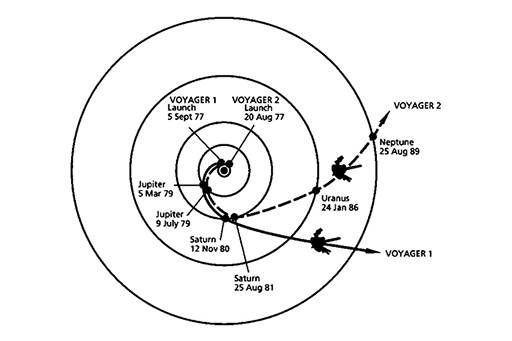1.2 Voyager
Even while NASA was launching its two Pioneers, the budget for its ‘Grand Tour’ mission was being cut. Fortunately NASA was able to salvage a more modest programme called Mariner Jupiter–Saturn, soon to be renamed Voyager. These two probes were launched in 1977, flying past Jupiter in 1979 with their arrivals timed to fly as close to as many moons as possible either on the way in or on the way out. Voyager 1 reached Saturn in December 1980 and was then diverted to pass behind Titan so that its atmosphere could be studied by beaming a radio signal through it towards Earth. This encounter flung Voyager 1 onwards at an angle of 35° above the plane of the Solar System. It is now the most distant human artefact, about 163 times further from the Sun than the Earth at the start of 2024, but it is still in touch thanks to its radioactive power source, sending back data on the local particle density and magnetic field strength.

Voyager 2 reached Saturn in August 1981, and because it was still functioning very well, permission was granted to keep the project alive and continue onwards to Uranus (1986) and Neptune (1989). Although the cameras had not been designed to function in the low light levels encountered so far from the Sun and the antenna was not designed to transmit large volumes of data over such a great range, software fixes were transmitted to its on-board computer that circumvented most problems.
There was no way to direct Voyager 2 onwards to Pluto (at the time the most distant known target), which will remain largely mysterious until the New Horizons mission flies past in July 2015.
Headline moon discoveries by the two Voyager probes include:
- discovery of erupting volcanoes on Io (a moon of Jupiter)
- three new moons of Jupiter
- dense atmosphere of Titan (the largest of Saturn’s moons)
- seven new moons of Saturn
- geological variety on Miranda and Ariel (two of Uranus’ moons)
- ten new moons of Uranus
- nitrogen-ice polar cap on Triton (the largest of Neptune’s moons)
- six new moons of Neptune.
